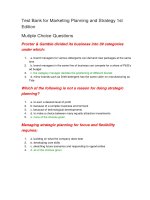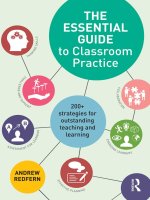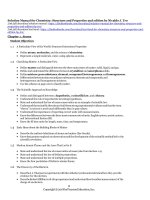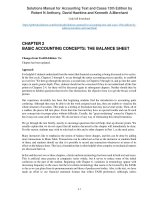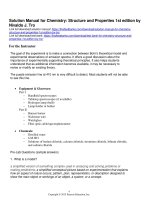Ebook Surgical handicraft manual for surgical residents and surgeons (1st edition): Part 1
Bạn đang xem bản rút gọn của tài liệu. Xem và tải ngay bản đầy đủ của tài liệu tại đây (15.91 MB, 122 trang )
Surgical Handicraft
Manual for Surgical Residents and Surgeons
Surgical Handicraft
Manual for Surgical Residents and Surgeons
Editor
R Dayananda Babu MS MNAMS
Professor and Head
Department of General Surgery
Sree Gokulam Medical College and Research Foundation
Venjaramoodu, Thiruvananthapuram, Kerala, India
Foreword
PGR Pillai
The Health Sciences Publisher
New Delhi | London | Philadelphia | Panama
Jaypee Brothers Medical Publishers (P) Ltd
Headquarters
Jaypee Brothers Medical Publishers (P) Ltd
4838/24, Ansari Road, Daryaganj
New Delhi 110 002, India
Phone: +91-11-43574357
Fax: +91-11-43574314
Email:
Overseas Offices
J.P. Medical Ltd
83, Victoria Street, London
SW1H 0HW (UK)
Phone: +44 20 3170 8910
Fax: +44 (0)20 3008 6180
Email:
Jaypee-Highlights Medical Publishers Inc
City of Knowledge, Bld. 237, Clayton
Panama City, Panama
Phone: +1 507-301-0496
Fax: +1 507-301-0499
Email:
Jaypee Medical Inc
The Bourse
111 South Independence Mall East
Suite 835, Philadelphia, PA 19106, USA
Phone: +1 267-519-9789
Email:
Jaypee Brothers Medical Publishers (P) Ltd
17/1-B Babar Road, Block-B, Shaymali
Mohammadpur, Dhaka-1207
Bangladesh
Mobile: +08801912003485
Email:
Jaypee Brothers Medical Publishers (P) Ltd
Bhotahity, Kathmandu
Nepal
Phone: +977-9741283608
Email:
Website: www.jaypeebrothers.com
Website: www.jaypeedigital.com
© 2015, Jaypee Brothers Medical Publishers
The views and opinions expressed in this book are solely those of the original contributor(s)/author(s) and
do not necessarily represent those of editor(s) of the book.
All rights reserved. No part of this publication may be reproduced, stored or transmitted in any form or by
any means, electronic, mechanical, photocopying, recording or otherwise, without the prior permission in
writing of the publishers.
All brand names and product names used in this book are trade names, service marks, trademarks or
registered trademarks of their respective owners. The publisher is not associated with any product or
vendor mentioned in this book.
Medical knowledge and practice change constantly. This book is designed to provide accurate, authoritative information about the subject matter in question. However, readers are advised to check the most
current information available on procedures included and check information from the manufacturer of each
product to be administered, to verify the recommended dose, formula, method and duration of administration, adverse effects and contraindications. It is the responsibility of the practitioner to take all appropriate
safety precautions. Neither the publisher nor the author(s)/editor(s) assume any liability for any injury and/
or damage to persons or property arising from or related to use of material in this book.
This book is sold on the understanding that the publisher is not engaged in providing professional medical
services. If such advice or services are required, the services of a competent medical professional should
be sought.
Every effort has been made where necessary to contact holders of copyright to obtain permission to reproduce copyright material. If any have been inadvertently overlooked, the publisher will be pleased to make
the necessary arrangements at the first opportunity.
Inquiries for bulk sales may be solicited at:
Surgical Handicraft: Manual for Surgical Residents and Surgeons
First Edition: 2015
ISBN 978-93-5152-722-0
Printed at
Dedicated to
My teachers and my students
(both undergraduates and postgraduates in surgery)
My uncle Late Mr N Soman, SILO of Singapore
My Late parents Mr Raghavan and Mrs Mallakshy
and
My wife Dr Geetha Bhai and my son Deepak D Babu for
their love and tolerance of yet another intrusion into the
family life as the project took shape.
GREAT QUOTATIONS
“Let the ultimate truth prevail
Let the ultimate knowledge prevail
Let the infinite and eternal happiness prevail”.
“Medicine is an art, not a trade
A calling, not a business
A calling in which your heart will be equally used as your head”.
—William Osler
“Where there is love for humanity
there is love for the art of Medicine”.
—Hippocrates
“To cure occasionally
To relieve sometimes
To comfort always”.
—Louis Pasteur
“Two things are infinite:
the Universe and the human stupidity
and I am not sure about the Universe”.
—Albert Einstein
“Don't waste your time with explanations:
People only hear what they want to hear”.
—Paulo Coelho
CONTRIBUTORS
Ganesh Divakar MS MCh
Consultant Neurosurgeon
Saga Institute of Management Studies (SIMS)
Kollam, Kerala, India
John S Kurien MS DNB FAIS FICS
Professor
Department of Surgery
Government Medical College, Kottayam
Kottayam, Kerala, India
PG Venugopalan MD
Associate Professor
Department of Anesthesiology
Sree Gokulam Medical College and Research Foundation
Venjaramoodu, Thiruvananthapuram, Kerala, India
R Dayanada Babu MS MNAMS
Professor and Head
Department of General Surgery
Sree Gokulam Medical College and Research Foundation
Venjaramoodu, Thiruvananthapuram, Kerala, India
Tigy Thomas Jacob D Ortho DNB Ortho
Additional Professor
Department of Orthopedics
Superintendent, Medical College and Hospital
Kottayam, Kerala, India
FOREWORD
Surgery is that branch of medicine in which an operation (handicraft or
instrumental intervention) may have a great role to play in the treatment.
Hence, different to other medical disciplines, it requires the development
of a physical craft with cognitive growth. Accuracy, speed, economy of
effort, coordination of actions, efficient and appropriate surgical skill are all
important factors in the art and practice of surgery.
There has been a void in Surgical Handicraft Textbooks since Pye's Surgical
Handicraft: A Manual of Surgical Manipulations, Minor Surgery (1893). In the
preface to the very first edition Pye wrote, “In this book I have endeavored to
describe the details of surgical work as it appears from the point of view of
house surgeons and dressers in surgical wards”.
This book by Dr R Dayananda Babu provides a unique learning
environment wherein surgical residents can acquire technical skills,
knowledge and confidence; the essentials of the craft of surgery. The contents
of the book is appropriately described by its title, Surgical Handicraft: Manual
for Surgical Residents and Surgeons. This book will help all doctors intending a
surgical career or surgically related career as a foundation text and, of course,
in day-to-day “general practice” which is fast disappearing.
This book is written with emphasis on standard surgical principles and
techniques. It outlines fundamental principles of major and minor surgery;
to ensure the success of procedures, to help to avoid pitfalls and to minimize
the risk of complications. The book Surgical Handicraft: Manual for Surgical
Residents and Surgeons has been written primarily for house surgeons and
junior residents, with constant attention to the thought, “Is this something a
student should know when he or she finishes undergraduate medical study?”
The field of surgical techniques is broad and varied and “Surgical Handicraft”
covers the many techniques effectively utilized to perform the training
of today's medical graduates, residents and young surgeons with existing
evidence-based knowledge.
Dr R Dayananda Babu has been a long-time colleague of mine. His vast
knowledge of both theory and the art of surgery is personally known to me.
This is his fifth book.
It is an honor to be associated with this textbook. I recommend this book
as a companion and compendium to surgical studies, with full satisfaction.
PGR Pillai
Former Professor and Head, Department of Surgery
Government Medical College, Kottayam
Dean, Faculty of Medicine, Mahatma Gandhi University, Kottayam
Dean of Faculty of Medical Science
Cochin University of Science and Technology, Kochi
Kerala, India
PREFACE
It is with great pleasure and immense satisfaction I am writing the preface of
my second book titled Surgical Handicraft: Manual for Surgical Residents and
Surgeons
Medical students who have completed their course and are entering
the clinical training, especially in surgery, must be well educated in basics.
Most of the time, they are not guided properly during their house surgency.
This book is meant for the neophyte intern whose main interest at present
is learning multiple choice questions (MCQs) rather than getting hands-on
training. The junior residents also get into the surgery departments without
proper hands, on exposure during house surgency.
The famous quotation by Virchow is always there in my mind—“Brevity in
writing is the best insurance for its perusal.” This book is written in a notebook
style. The presentation is simple and lucid with liberal use of pictures to
facilitate the reading. Basic topics, such as handwashing, gloving, universal
precautions, fluid resuscitation, insertion of intravenous cannula, urinary
catheter, and nasogastric tube, are discussed.
I hope that this book may contribute to improving the training of house
surgeons and junior residents. Finally, let me quote Isaac Newton—
“If I have seen a little further it is by standing on the shoulders of giants—
My teachers”.
R Dayananda Babu
ACKNOWLEDGMENTS
In the early 2013, I got a call from Shri Jitendar P Vij (Group Chairman) of M/s
Jaypee Brothers Medical Publishers (P) Ltd, New Delhi, India, requesting me
to write a book in this title. He put a deadline for me and was December 2013.
Today, the book release was possible because of his constant encouragement
and frequent reminders.
I am grateful to my esteemed contributors:
• Professor (Dr) John S Kurien, MS, DNB, FAIS, FICS (Government Medical
College, Kottayam)
• Dr Tigy Thomas Jacob, D Ortho, DNB Ortho (Additional Professor,
Department of Orthopedics and Superintendent, Medical College and
Hospital, Kottayam)
• Dr PG Venugopalan, MD (Associate Professor, Department of
Anesthesiology, Sree Gokulam Medical College and Research Foundation,
Thiruvananthapuram)
• Dr Ganesh Divakar, MS, MCh (Consultant Neurosurgeon, Saga Institute of
Management Studies, Kollam).
I am thankful to Dr Arun K Aipe, final year postgraduate student in General
Surgery, for spending many evening times with me in doing the computer
work, helping me to insert the pictures and photographs in appropriate places,
and arranging the chapters. The medical illustration part of the orthopedic
chapter was done in a fantastic professional manner by none other than the
author himself— Dr Tigy Thomas Jacob. Hats off to his artistic skill also. The
remaining illustrations were done by my first year postgraduate student Dr
Muhammed Muneer, Sree Gokulam Medical College and I am very happy
with his job.
Finally, I must thank Professor (Dr) PGR Pillai, Special Officer, for writing
the foreword. He has made commendable contribution in starting the new
Government Medical Colleges in the state. He was responsible for starting
Pariyaram Medical College, Cochin Medical College and many other projects
while he was the Superintendent. The Cancer Care Centre is a standing
monument for his hard work. I was an assistant to him for several years and I
learned many basics from him.
I would also like to thank Shri Jitendar P Vij (Group Chairman), Mr Ankit
Vij (Group President) and Mr Tarun Duneja (Director–Publishing) of M/s
Jaypee Brothers Medical Publishers (P) Ltd, New Delhi, India.
CONTENTS
1.
Model Conduct for House Surgeons/Residents
1
2.
Duties and Responsibilities of House Surgeons/Interns
(Compulsory Rotating Resident Internship—CRRI)
R Dayananda Babu
3
R Dayananda Babu
3. 9 Tips for House Surgeons/Residents
R Dayananda Babu
6
4. Handwashing Practice
R Dayananda Babu
10
5. Gloving Techniques
R Dayananda Babu
14
6. ‘Safe Surgery Saves Lives’— A WHO Initiative
R Dayananda Babu
18
7.Methicillin-resistant Staphylococcus aureus (MRSA)
R Dayananda Babu
21
8. Surgical Site Infection
R Dayananda Babu
23
9. Intravenous Fluids and Postoperative Fluid Management 27
R Dayananda Babu
10. Intravenous Cannulation
PG Venugopalan
37
11. Central Venous Catheter
John S Kurien
43
12. Cardiopulmonary Resuscitation
PG Venugopalan
54
13. Sutures
John S Kurien
62
14. Preoperative Preparation in General for Elective Surgery
R Dayananda Babu
67
15. Preoperative Preparation of Common Operations
R Dayananda Babu
73
16.
Classification of Surgical Cases and ASA
Classification of Physical Fitness
R Dayananda Babu
79
xviii
Surgical Handicraft
17. Prophylactic Antibiotics in Surgery
R Dayananda Babu
Prophylaxis of Deep Vein Thrombosis and
Pulmonary Embolism
R Dayananda Babu
81
18.
19. Surgical Blades, Skin Incisions and Acute Wound Closure
R Dayananda Babu
86
91
20. Local Anesthetics Used for Minor Surgery
R Dayananda Babu
101
21. Digital Nerve Blocks (Finger and Toe Blocks)
R Dayananda Babu
104
22. Minor Surgical Procedures of Subcutaneous Swellings
R Dayananda Babu
107
23. Ingrowing Toe Nail
R Dayananda Babu
114
24. Incision and Drainage of Abscess
R Dayananda Babu
117
25. Venous Cutdown
John S Kurien
120
26. Resuscitation in Trauma
R Dayananda Babu
124
27. Intercostal Drainage Tube
John S Kurien
135
28. Urethral Catheterization
R Dayananda Babu
145
29. Nasogastric Intubation (Ryle’s Tube)
R Dayananda Babu
157
30. Bandaging Techniques
John S Kurien
162
31.
Use of Antiseptics and Ointments for
Wound Management
R Dayananda Babu
174
32. Head Injury
Ganesh Divakar
178
33. Orthopedics
R Dayananda Babu
198
Index267
Chapter
1
Model Conduct for House
Surgeons/Residents
R Dayananda Babu
CODE OF CONDUCT
1.
Character of the physician:
“An upright man, instructed in the art of healing,
Pure in character and diligent in caring for the sick,
He should be modest, sober, patient, prompt to do his whole duty without
anxiety,
Pious without going so far as superstition.”
2. Physician’s responsibility:
The objective of the medical profession is to render service to humanity
with full respect for the dignity of man.
3. Develop the affective domain (heart):
“Medicine is an art, not trade.
A calling, not business,
A calling in which your heart will be equally used as your head”
—William Osler
“It is with heart one sees rightly,
what is essential is invisible to the eye”
“Where there is a love for humanity, there is love for the art of medicine”
—Hippocrates
“To cure occasionally,
To relieve sometimes and
To comfort always”
—Louis Pasteur
4. Develop soft skills:
• Communication (Communicate to the patient and bystanders)
• Empathy: Experiencing the feelings and thoughts of another person
• Humility: State of being humble
5. Success will depend upon your attitude:
• Attitude will decide the altitude.
• “The greatest discovery of my generation is that human beings can
alter their lives by altering their attitudes of mind.”—William James
(Harvard University).
2
Surgical Handicraft
6. Reliability and punctuality are the two most important qualities of a
successful doctor.
7. Dress code:
• A clean white coat always looks professional
• Dirty, polo–necked sweaters are not acceptable
8. Be well equipped:
• Carry a spiral diary to note down the work, rather than rely on memory
• Carry stethoscope, pen torch, knee hammer, measuring tape, etc.
9. Never display the arrogance of office: Arrogance is a sign of ignorance
and immaturity.
There is no role for high handed behavior inside the hospital.
10. Never make comments like “This patient should have been sent to
hospital much earlier”.
11. Primum non nocere (primarily do no harm): In any real doubt or
difficulty, consult the senior doctor. Know your limitations.
12. A doctor should not run except in dire emergency, such as cardiac arrest
or total respiratory obstruction.
13. Get along well with seniors, nurses, paramedical staff, technicians and
subordinates. The intelligent resident can learn a lot from the nursing
staff.
14. Give due respect to senior doctors and doctors coming from other
institutions.
15. Be an active listener: Active listening encourages the patients to tell his
or her story of the illness.
16. Know how to break bad news (Read tips for house surgeons).
17. Avoid social evils like smoking, alcohol and drugs:- Doctor must be a role
model for the community.
18. Always look confident.
Chapter
2
Duties and Responsibilities of
House Surgeons/Interns
(Compulsory Rotating Resident Internship—CRRI)
R Dayananda Babu
1. Training period: House surgency is a training period and forms part of
the curriculum. Only after successful completion of this training program
you are eligible for permanent registration. You get hands on training of
various ward procedures, suturing techniques, minor operations, etc.
during this period and you are always supervised by a senior doctor.
2. Resident doctor (24 × 7): the intern is in charge of the life and health of
his patient with continuous medical cover. He is on call duty for 24 hours
7 days a week. He must be staying in the resident’s area of the hospital.
3. Time keeping: They should report for duty 30 minutes before the
consultant is expected. He/she should take Preliminary rounds, note
down the vital signs, collect the investigation results, write the progress
notes and send appropriate investigations, etc. Those who are on casualty
duty should relieve the night duty house surgeon at the correct time
(8.00 am).
4. Inform your whereabouts to the duty nurse and operator: It is better
to display your mobile number in the ward concerned.
5. Case sheet writing: Complete the case sheets within 24 hours of
admission and this must be written legibly. All documentations in the
case sheets must be recorded with date and time. Every day you should
write the daily progress in the concerned sheet with date and time. Do not
write ‘repeat 1, 2, 3’ when you start a fresh page of doctors orders (instead
write the entire orders). When there is cancellation of an order cross the
order vertically with date and time. It is better to review the entire orders
when there are too many cancellations. All laboratory results must
be entered in the case sheets. Always use polite language for writing
consultations. Use red ink only for writing night instructions. Whenever
you attend a call during duty hours, record your clinical findings in the
case sheets and if you prescribe medications, it should be noted in the
case sheet with date, time, and your signature. When you discharge
a patient, the facing sheet of the case sheet must be filled up. The final
4
Surgical Handicraft
diagnosis (if pathology report is there, that will form the final diagnosis)
must be written in capital letters, so also the name of the operation. There
must be a discharge summary written legibly in the facing sheet. Always
mention whether the patient is cured, relieved, dead, or otherwise. If
you are discharging a patient Against Medical Advice (DAMA) use the
appropriate printed form in the case sheet. If the patient is sensitive to
any drug it should be noted with block letters in red ink in front of the
file/case sheet. This is applicable also for HBSAg and MRSA.
6. Prescribing drugs: Always write the prescription legibly (better to write
the pharmacological name rather than the brand name) and put your
signature along with your full name and designation. If you are not sure
about the dose and mode of administration do not hesitate to ask the
senior. You should also know the contraindications for the drug and
the various possible reactions. Test dose should be administered for
penicillin group of drugs and other drugs which can produce reactions.
7. Five day rule for antibiotics: Antibiotics once prescribed should not
be continued indefinitely. It is better to ask the consultant whether to
continue it or not at the end of five days.
8. Writing a request form for laboratory: Write the request legibly. Write
the name, age, IP No. and unit of the patient. Give a brief clinical history,
and mention previous diagnosis and pathology reports if any. The name
of the requesting doctor and designation must be mentioned and should
be properly signed.
9. Getting ready for rounds: The house surgeon must present the case
during rounds. He will be standing on the left side of the patient facing
the consultant. He should know the vital signs of the patient, any night
events that has happened, drugs given to the patient and any fresh
complaints for the patient.
10. Attending a call: While on duty you will be called to see the patients
in the ward. He/She should immediately attend the call, examine the
patient after taking brief account of the history and note down the
clinical findings in the case sheets with date and time. Ensure that
your instructions are executed by the nurse. For dying patient institute
resuscitative measure and CPR if required. In the event of death of a
patient, inform the duty MO immediately and act in accordance to his
advice.
11. Preparation of patient for special investigations, invasive procedures,
surgical procedures, delivery, etc.: Carry out the preparations required
for a particular procedure. If you don’t know the preparation, contact the
concerned department/specialist.
12. Never send unstable patients for scanning and other procedures
unattended: Whenever you send a sick patient to another department, it
is your duty to accompany the patient, so that any untoward incident can
be tackled.
13.Consent: Informed consent must be taken for all procedures, special
investigations and surgical procedures after explaining the procedure.
Duties and Responsibilities of House Surgeons/Interns
Explain the merits, demerits, benefits expected and the risks involved
in the procedure. Use the language which the patient and relatives
can understand. Avoid technical terms. Explain the necessity of the
procedure. Discuss also the alternative procedures available. Be realistic,
however do not scare the patient. The consent must be signed by the
patient himself if he/she is adult. It is better to get the signature of a
witness.
14. Arrival of a consultant to see your case: When another specialist comes
to see your case ensure that you are present there to brief him about the
patient and clarify his doubts.
15. Discharge card and reference letter: Discharge card is a permanent
record which will go to other doctors and hospitals. Therefore it should
be legibly written. The final diagnosis and the name of the operation
should be written in capital letters. It is important to enter all significant
laboratory values and investigation reports in brief. After writing the card
it should be shown to a senior doctor and get it approved before handing
over to the patient. Whenever you write a reference letter to another
centre it is advisable to prepare it and get it approved by a senior person.
16. Death certificate and medico legal formalities are done by the duty
medical officer. Please confirm the death with the help of a senior
doctor before declaring it.
17. Log book: The log book is permanent record of your day to day ward
work and it must be completed at the end of your posting. There is a
printed assessment sheet for each posting and the book will be evaluated
by the concerned unit chief and the appropriate score will be given.
18. Take leave only after prior sanction: The house surgeon is eligible for
20 days of leave as noted below.
• Medicine including psychiatry
– 3 days
• Surgery including anesthesia
– 3 days
• Speciality (Casualty, ENT, Ophthal, Elective – one day each) – 4 days
• Obstetrics and gynecology
– 3 days
•
Pediatrics– 2 days
• Community medicine
– 3 days
•
Orthopedics – 2 days
5
Chapter
3
9 Tips for House
Surgeons/Residents
R Dayananda Babu
Tip 1 – Be five star doctors (WHO)
The five star qualities of a doctor are:
1. Care provider.
2. Leader.
3. Manager.
4. Decision maker.
5. Communicator.
Tip 2 – Remember the four pillars of ethics
1. Patient autonomy
The most important norm of medical practice is patient autonomy,
which granted the patient the right to get treated or not, the right to
accept or reject a certain type of treatment. For instance, certain sections
of Christianity called Jehovah Witness do not accept blood transfusion.
In such cases, we have to give first preference to the choice of the patient,
the second to that of spouse and third to the view of the relatives.
2. Beneficence
All actions of physicians should be aimed at the good of the patient. This
is the second norm to be addressed in ethics.
3. Nonmaleficence
Nonmaleficence means that doctors should ensure that his approach
did not result in a wrong being done to the patient, i.e. Primum non
nocere— primarily do no harm to the patient.
4. Spirit of generosity and service
Spirit of generosity and service is the most ideal for a doctor.
Tip 3 – Practice handwashing—(Refer to Chapter 4)
Tip 4 – Practice universal precautions
1. All hospital staff must adhere rigorously to protective measures which
minimize exposure to the diseases transmitted through blood, blood
products and body fluids.
